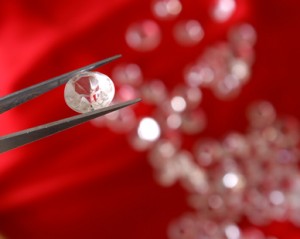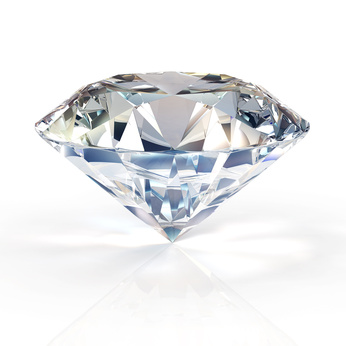Is There a Way to Repair a Chipped Stone?
Unfortunately, the answer is no. Once damaged, a stone cannot be restored to its previous integrity.
What’s even worse is that this diamond is now even more likely to break if hit again since its internal structure has already been weakened.

Once damaged, a diamond cannot be restored to its previous integrity.
However, if your stone has been chipped, you still have several options.
Is Your Diamond Insured?
Some diamonds come insured against certain damage. Check your insurance policy to see whether it covers accidental chips, scratches, etc.
You may need to talk to your insurance company to see if it will pay for a replacement stone. It is possible that you can get a new diamond and save yourself a lot of hassle.
Exchange Your Diamond
You may be able to exchange your damaged diamond for a new one at the jewelry store. However, this will come at a price. Since a chip is considered a flaw in the stone, your diamond’s clarity rating will go down. This means that the stone’s value will diminish. Therefore, if the jeweler agrees to the exchange, you will be given a stone that is worth less than what you paid for your original diamond.
You can also get a better stone by paying additional money while trading in your old one. In any case, only explore this option once you are certain that your insurance company will not cover the damage. Many jewelers will take the damaged stone, cut it again to eliminate the chip, and sell the newly formed diamond at a price lower than what the original was worth.
This brings us to your last option – having your damaged diamond recut.
What Is Recutting and How Can It Help Me?
Recutting is simply the process through which a jeweler creates a smaller stone out of a bigger one.
As the name suggests, the diamond is cut again, with part of it being eliminated, and the stone goes down in carat weight. Lower carat weight means that your diamond also becomes less valuable. How much value your stone will lose will depend on how serious the damage is. The bigger the chip, the more of the diamond your jeweler will need to cut out.
What’s more, recutting will cost you additional money. So, unless your insurance covers the damage, you will likely need to spend some money in order to alter the stone or get a new one.
If you don’t want to pay more and the chip doesn’t concern you much, you can always choose to live with it. Whatever you do, always remember to handle your diamonds with care.
How to Prevent Your Diamond from Chipping or Cracking
Check Your Prongs
One of the most common reasons diamonds chip is that the prongs holding them in the setting are bent or broken.

Once damaged, a stone can be easily nicked or cracked again if you hit it.
Even when only one prong is damaged, your diamond is no longer held securely in its mounting.
If you happen to hit your ring somewhere, for example, the part of the stone where the prong is out of alignment would not be protected and the diamond can easily chip when bumped.
That’s why you should always have your prongs repaired as soon as you notice any damage to them.
Be Careful With Tension Settings
There are some settings that pose a higher risk to the stones mounted in them than others.
A good example is the tension setting, in which the diamond is held in place by the two ends of the ring that press tightly against the stone’s sides.
The first problem with this mounting is that it exerts pressure on the diamond, and you have to be careful not to bump your ring or the stone may chip in the setting.
If you are going to have your diamond set in this type of setting, be aware that sometimes stones may also get chipped when mounted in rings with such a design.
The second problem with tension settings is that they leave a good portion of the diamond exposed to hits that may be damaging. So, if you have a ring with this kind of mounting or you’re planning on getting one, be very careful with it.
Avoid Diamonds with Lots of Inclusions
Nobody likes heavily included diamonds – not only are these stones not the best visual treat, but they are also more prone to chipping and cracking. The more internal flaws a diamond has and the bigger they are, the weaker its internal structure is.
In general, stay away from diamonds whose clarity is graded I2 or I3 on the scale of the G.I.A. (Gemological Institute of America) – the inclusions in those stones can sometimes threaten their integrity.
Handle Chipped Diamonds with Care
If your diamond has already been chipped, you should be extra careful with it. Once damaged, a stone can be more easily nicked or cracked a second time if you hit it where it is already vulnerable.
Examine your diamond by using a loupe or by touching it to see if you can detect any chips. If your stone is damaged, handle it with care.
It is best if such a diamond can be set in a mounting that covers the damaged place and protects it.
Secure Diamonds with Thin Edges
Round diamonds with thin girdles (this is how the edge of the stone is called) are also at risk of chipping as the edges of these stones are very vulnerable.
If you have such a diamond, you should try to have it set in a mounting that protects the stone’s girdle well.
In a similar way, there are stones that are more prone to chipping simply because of the shape they are cut in.
Typical examples of such stones are trillion and marquise cut diamonds, which have sharp edges and points that can make these stones chip more easily at their ends.
In general, have such shapes set in a mounting that can adequately protect their edges – a V-prong setting is a good solution.














